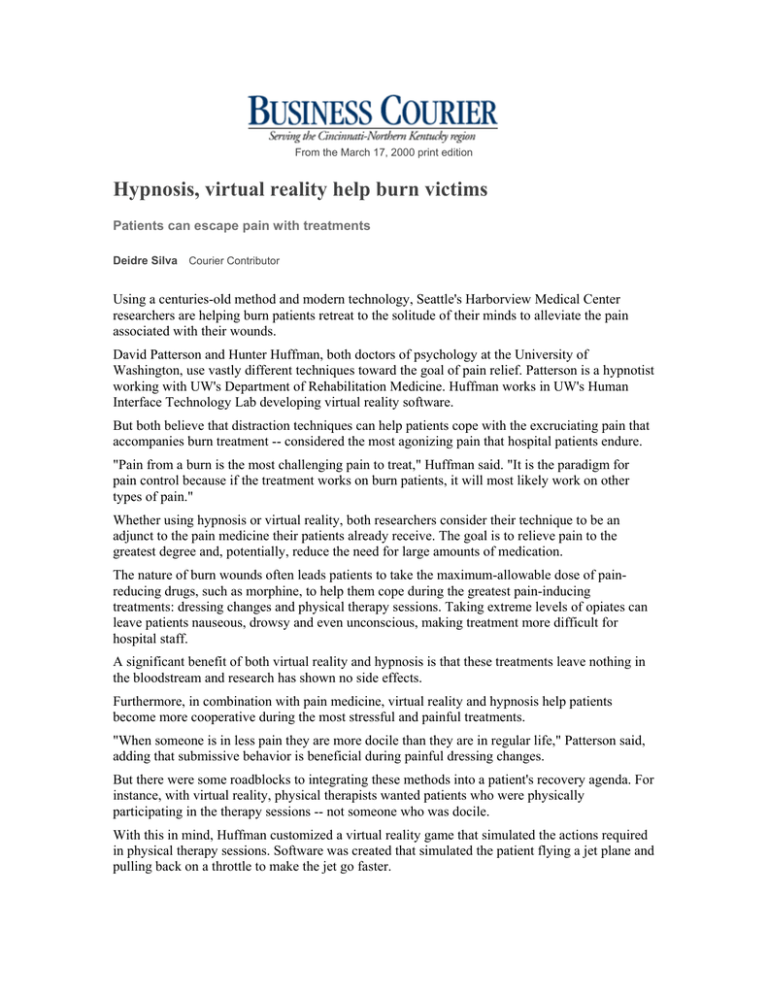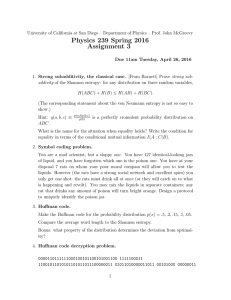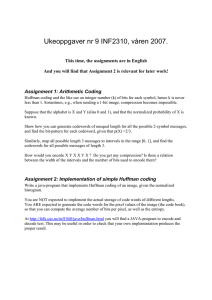Hypnosis, virtual reality help burn victims
advertisement

From the March 17, 2000 print edition Hypnosis, virtual reality help burn victims Patients can escape pain with treatments Deidre Silva Courier Contributor Using a centuries-old method and modern technology, Seattle's Harborview Medical Center researchers are helping burn patients retreat to the solitude of their minds to alleviate the pain associated with their wounds. David Patterson and Hunter Huffman, both doctors of psychology at the University of Washington, use vastly different techniques toward the goal of pain relief. Patterson is a hypnotist working with UW's Department of Rehabilitation Medicine. Huffman works in UW's Human Interface Technology Lab developing virtual reality software. But both believe that distraction techniques can help patients cope with the excruciating pain that accompanies burn treatment -- considered the most agonizing pain that hospital patients endure. "Pain from a burn is the most challenging pain to treat," Huffman said. "It is the paradigm for pain control because if the treatment works on burn patients, it will most likely work on other types of pain." Whether using hypnosis or virtual reality, both researchers consider their technique to be an adjunct to the pain medicine their patients already receive. The goal is to relieve pain to the greatest degree and, potentially, reduce the need for large amounts of medication. The nature of burn wounds often leads patients to take the maximum-allowable dose of painreducing drugs, such as morphine, to help them cope during the greatest pain-inducing treatments: dressing changes and physical therapy sessions. Taking extreme levels of opiates can leave patients nauseous, drowsy and even unconscious, making treatment more difficult for hospital staff. A significant benefit of both virtual reality and hypnosis is that these treatments leave nothing in the bloodstream and research has shown no side effects. Furthermore, in combination with pain medicine, virtual reality and hypnosis help patients become more cooperative during the most stressful and painful treatments. "When someone is in less pain they are more docile than they are in regular life," Patterson said, adding that submissive behavior is beneficial during painful dressing changes. But there were some roadblocks to integrating these methods into a patient's recovery agenda. For instance, with virtual reality, physical therapists wanted patients who were physically participating in the therapy sessions -- not someone who was docile. With this in mind, Huffman customized a virtual reality game that simulated the actions required in physical therapy sessions. Software was created that simulated the patient flying a jet plane and pulling back on a throttle to make the jet go faster. In reality, however, when the patient pulls back on the jet's throttle, the patient would really be pulling back on a real object or squeezing a ball -- actively taking part in their therapy session that would otherwise be too painful to endure. "This way, the pain isn't prohibiting them from the benefits of physical therapy sessions and the patient doesn't get anxiety-stricken about his sessions," Huffman said. "This incorporates the VR experience with the recovery experience." Huffman's most recent challenge is creating a fiber-optic virtual reality helmet that can be used during dressing changes in the most painful stage of burn recovery -- when the patient is submerged in a bathtub to help loosen the bandages. "This development would help us access patients in the earlier stages of the recovery process," Huffman said, He added that with a grant from the Washington State Firefighters Association, he is now developing the $50,000 non-electric helmet that can be used in bathtubs. Eighty percent of all burn treatment takes place in bathtubs, he said. Huffman also has relied on private donations to keep his project afloat. He and Seattle businessman Ross Chambers have raised more than $60,000 from Seattle businesses such as Airborne Express, Optiva Corp. and Seattle Steam. Huffman said that the money would go to develop more advanced software and to purchase the conventional, electric $10,000 helmet. Because a third of burn center patients are children, most of the virtual reality research has been conducted on kids. Adults, somewhat surprisingly, have also responded well to the VR treatment. "I think that the extent of the pain makes them highly motivated to suspend disbelief and participate in the VR treatment," Huffman said. "VR draws the body in to a simulated environment to help distract the patient from the pain." Patterson has had a similar experience with hypnosis. "Psychological techniques fit in well with the pace of trauma care," he said. "The trauma almost makes them hypnotized, anyway." Both Patterson and Huffman's distraction techniques are based on the idea that there is a large psychological component to pain and pain relief. Huffman foresees future uses in other areas of health care, such as chemotherapy and birth -instances where patients experience extreme levels of pain, but there are concerns about medication levels. "There is a strong psychological component to pain and these two methods are psychological solutions to psychological problems," he said. "Everyone has a limited amount of attention and a limited amount of stimuli that can be processed." © 2000 American City Business Journals Inc. [http://cincinnati.bizjournals.com/cincinnati/stories/2000/03/20/focus3.html]


